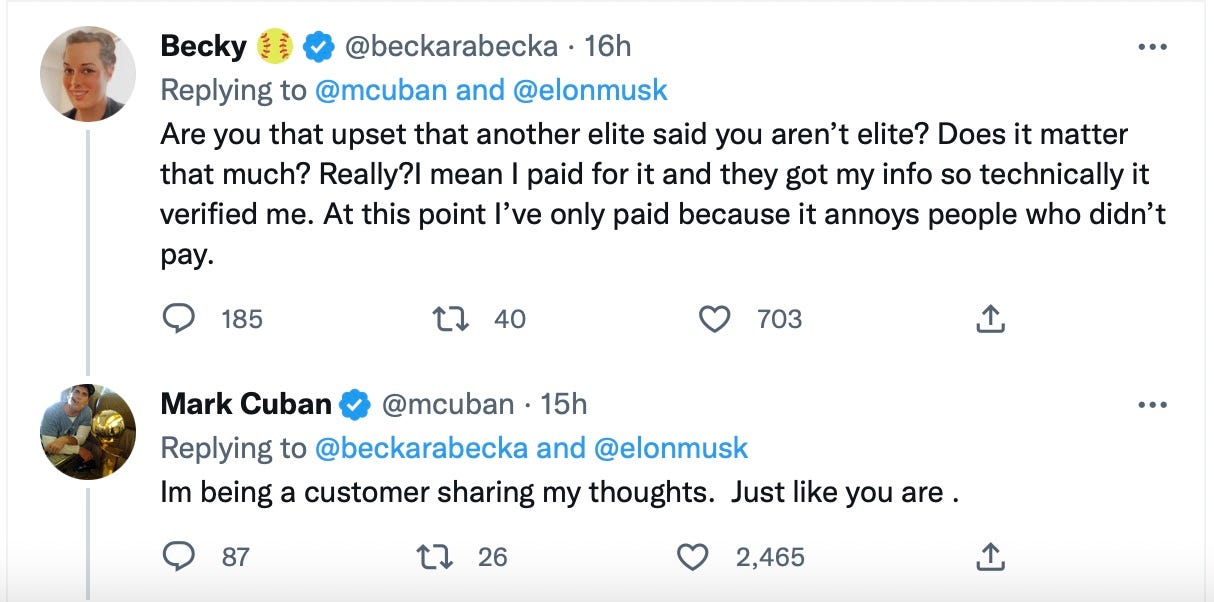Elon Won't Make Money By Making Twitter Less Pleasant to Read
He wants to charge people for the privilege of shouting at more readers. But people don't like being shouted at. Plus: Crypto comeuppance.
Dear readers,
On Wednesday, I wrote about my initial reactions to the midterm elections — that post is for paying subscribers — and I’m planning a longer piece soon, once we have results from Arizona and Nevada.
Today, I have thoughts for you on Twitter and on this week’s spectacular cryptocurrency implosion.
People don’t like random strangers yelling at them, Elon. When social media platforms curate the content they show to users, they have objectives. In general, they want to show you relevant and engaging content so you keep using the app. If they’re showing you ads, they want those ads to be relevant to your interests, so you’ll click on them and they’ll make money. And they give you tools as a user to optimize that experience — at the most basic level, you decide who you do and don’t want to follow, and that drives what content you see.
Those are all statements about the experience of reading a platform like Twitter. But now that he is in charge, Elon Musk has been especially focused on what happens with content you post. In particular, he is encouraging the masses to pay $8 a month for a checkmark, and offering the promise that if they do so they will “rocket to the top of replies, mentions and search” — that is, if you pay, the algorithm will cause other users to see whatever you posted more often.
You can see how this new initiative would interfere with the old objective, right? Mark Cuban has tried to gently explain it to him:

The “rocket to the top” feature has largely not rolled out yet; it’s described as “coming soon” if you go to buy Twitter Blue. But Cuban is interacting with one aspect of it that is already implemented — if you buy Twitter Blue, you do already get a verification checkmark, and that means you burst into the mentions view Cuban uses, where he sees only verified users. What Cuban is really using this view for is in order to see replies from notable users, and allowing non-notable people to buy checkmarks degrades his user experience. He doesn’t like it.
Of course, you can’t make everyone happy all the time. Most users would rather not see advertising, but Twitter shows them ads because the advertisers pay and that makes it worth it. In a sense, the new checkmark buyers are advertisers — they pay Twitter some money, and Twitter shows their content to some users, ranked above content that might otherwise be algorithmically preferred based on those users’ preferences. Fair enough, this is an advertising-driven business. The key question then is: Is Twitter charging enough for this new form of advertising?
Twitter’s ad rates vary in a complex manner, but a typical average cost per thousand impressions (CPM) appears to be in the ballpark of $6. If an $8 monthly subscription causes your tweets to be seen at least an extra 1,400 times a month, then it’s cheaper than paid advertising. It’s not hard to see how you could generate many, many times that number of incremental impressions by using a paid checkmark to buy high placement in the replies to a high-follower account like Cuban’s.
I simply think Musk hasn’t thought this through very well, because he’s blinded by his very unusual personal experience.
Musk and his advisers are approaching the app from the place where they sit: They are big-deal Silicon Valley people, they feel oppressed by the press, and they resent the ability of some loser 26-year-old web journalist with 750 followers and a checkmark to shout over them. I will grant that they even have some good points about the tech press on the merits — it is often unfair, and it does have a strong bias toward negativity. (Just check out any of the media coverage of Substack to see this in action.) So it’s understandable that their personal preference is for it to be easier to shout back.
But most people aren’t on Twitter to shout at all — they’re on Twitter mostly to listen. And Musk’s vision for changing the app means they’ll increasingly be listening not to the people most likely to be interesting to them, but to people who have paid for the privilege of shouting at them. And that’s going to make using Twitter a less pleasant experience — not just for Mark Cuban but for people who follow Mark Cuban and read the threads he participates in.
Consider one of the “verified” replies to Cuban’s complaint tweet, which came from a user with 107 followers and a purchased checkmark:
Soon, this is the sort of tweet that’s going to “rocket to the top” of replies, mentions and search. If you degrade the user experience like that — serving up tweets from people who almost nobody follows willingly, who openly admit they enjoy using Twitter to annoy others — you’ll cause people to spend less time reading Twitter, which means you won’t be able to serve as many ads to Twitter readers. Basically, Musk is planning to impair Twitter’s existing advertising business by implementing a new one that comes with a much lower price-per-impression, and that’s bad business.
(In case you missed it, I wrote last week about how I think Elon might be stumbling toward monetizing one area where Twitter is already a social media market leader: porn.)
Crypto is bullshit. Last year, then-crypto magnate Sam Bankman-Fried appeared on the Bloomberg podcast Odd Lots, and one of the topics he discussed with journalists Matt Levine, Joe Weisenthal and Tracy Alloway was “yield farming.” This is a term for a particular type of crypto shenanigans involving high-yield lending: Roughly, you deposit your holdings of an established crypto coin (like Etherium) in a box, and in exchange the box periodically pays you a new, proprietary coin made by the maker of the box. Since market participants irrationally ascribe value to the new coin, the effective interest rate you can earn by lending out your Etherium can become quite high. Enthusiasm for the high interest rate causes more people to put their own assets in the box, and the enthusiasm for the box causes the market value of the new coin to rise, further improving the interest rate and drawing even more assets into the box until the value of the new coin goes to “infinity,” in Bankman-Fried’s words.
When Bankman-Fried described farming in these terms, the Bloomberg hosts were astounded. As Levine replied:
I think of myself as like a fairly cynical person. And that was so much more cynical than how I would've described farming. You're just like, ‘Well, I'm in the Ponzi business, and it's pretty good.’
This is the essence of crypto, and why I think it is not just bullshit but immoral bullshit.
Keep reading with a 7-day free trial
Subscribe to Very Serious to keep reading this post and get 7 days of free access to the full post archives.



